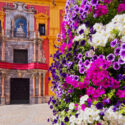In these lands the Celts, Iberians and Romans settled, although the most notable trace was undoubtedly left by the Arabs. Their legacy is present in the stony streets with a scent of jasmine. Strolling along the White Villages is travelling in time through routes with fortresses, crossing a unique natural environment: the parks of Grazalema and the Alcornocales. In the provinces of Cadiz and Malaga, hidden between the mountains, are the picturesque White Villages. Its name is due to the custom of its neighbours to whitewash the houses and its location, to the need of protecting themselves against the enemies of yesteryear. This way they have remained immune over the years.
The route also leads us to municipalities like Prado del Rey, el Bosque or Ubrique.
Amongst the most well-known villages of this route is Arcos de la Frontera. This town of Cadiz sits on a hill, 96 metres high and under which the river Guadalete flows. The Cabildo square, situated at the top of the village, is used as a viewpoint. There we’ll find the impressive castle, an old Muslim fortress and, from 1493 till the 18th century, residence of the Dukes of Arcos. Today it’s private property. Next to it is the Santa Maria church, erected above an old mosque, that took six centuries to be finished.
The unevenness suggests a calm visit, descending from the top to get lost in a labyrinth of narrow streets and patios. In the houses we’ll also find traces of a seigniorial past. The sumptuous residence of the earls of Aguila or the Mayorazgo palace, that has in its interior the oldest patio in the city, are proof of this.
The narrow alleyways host numerous churches and convents. Today, only one remains functioning, Las Mercedarias. Although it’s a cloister, the nuns prepare delicious cakes and pies that they sell to the inhabitants and visitors of the village.
We simply cannot leave Arcos without enjoying a sunset from one of its viewpoints. The Abades one, for example, offers a beautiful scenery with the San Agustin church in the background.
Mountains with a history
We leave Arcos and continue the road that will lead us to one of the other nineteen White Villages. The first one we’ll reach is about 20 kms away: Algar, known for having an unexpected Mexican style church.
The route also leads us to municipalities like Prado del Rey, el Bosque or Ubrique, famous for its leather craftsmanship. Also to Villaluenga del Rosario, where the bandits of the 19th century used to take refuge.
Zahara de la Sierra is a national monument, as well as a pretty village, olive oil producer and crowned by an impregnable Arab castle for centuries. Beyond Zahara’s reservoir we’ll reach Grazalema. Situated at the foothill of the natural park of the same name, this village is famous for its traditional textile industry.
In the easternmost extreme, we’ll find Torre Alhaquime, a small and calm municipality with steep streets and very picturesque. And back to Arcos, closing the circle, it’s well worth stopping in Bornos, a visit to its lake and tour the streets and gardens that arose around the Alcazar of Fontanar.
Plus
- If you’re travelling with family, why not pop over on Saturday to see the horse show of the Yeguada del Hierro del Bocado, in Jerez.
- If you enjoy nature, visit the Doñana Park sailing along the river Guadalquivir from Sanlucar de Barrameda.
- If you prefer sport, you can go on a mountain bike route through the Alcornocales. If you’re searching for culture, visit the Torre Tavira in Cadiz, the first in Spain that had a “dark camera” to stealthily observe the city.
We recommend to hire a car in Malaga for making the most from your visit to Andalucia.






